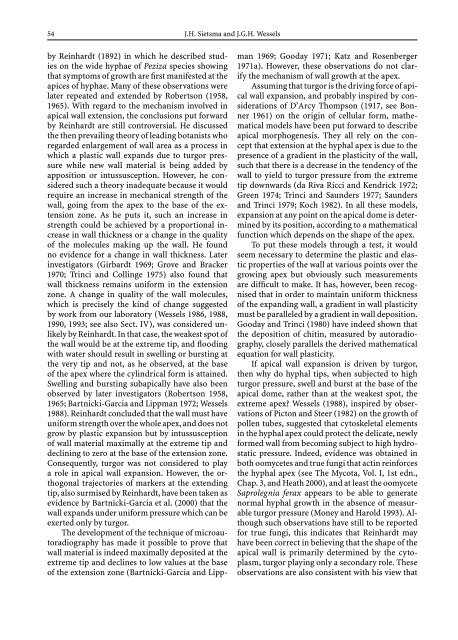Growth, Differentiation and Sexuality
Growth, Differentiation and Sexuality
Growth, Differentiation and Sexuality
You also want an ePaper? Increase the reach of your titles
YUMPU automatically turns print PDFs into web optimized ePapers that Google loves.
54 J.H. Sietsma <strong>and</strong> J.G.H. Wessels<br />
by Reinhardt (1892) in which he described studiesonthewidehyphaeofPeziza<br />
species showing<br />
that symptoms of growth are first manifested at the<br />
apices of hyphae. Many of these observations were<br />
later repeated <strong>and</strong> extended by Robertson (1958,<br />
1965). With regard to the mechanism involved in<br />
apical wall extension, the conclusions put forward<br />
by Reinhardt are still controversial. He discussed<br />
the then prevailing theory of leading botanists who<br />
regarded enlargement of wall area as a process in<br />
which a plastic wall exp<strong>and</strong>s due to turgor pressure<br />
while new wall material is being added by<br />
apposition or intussusception. However, he considered<br />
such a theory inadequate because it would<br />
require an increase in mechanical strength of the<br />
wall, going from the apex to the base of the extension<br />
zone. As he puts it, such an increase in<br />
strength could be achieved by a proportional increase<br />
in wall thickness or a change in the quality<br />
of the molecules making up the wall. He found<br />
no evidence for a change in wall thickness. Later<br />
investigators (Girbardt 1969; Grove <strong>and</strong> Bracker<br />
1970; Trinci <strong>and</strong> Collinge 1975) also found that<br />
wall thickness remains uniform in the extension<br />
zone. A change in quality of the wall molecules,<br />
which is precisely the kind of change suggested<br />
by work from our laboratory (Wessels 1986, 1988,<br />
1990, 1993; see also Sect. IV), was considered unlikely<br />
by Reinhardt. In that case, the weakest spot of<br />
the wall would be at the extreme tip, <strong>and</strong> flooding<br />
with water should result in swelling or bursting at<br />
theverytip<strong>and</strong>not,asheobserved,atthebase<br />
of the apex where the cylindrical form is attained.<br />
Swelling <strong>and</strong> bursting subapically have also been<br />
observed by later investigators (Robertson 1958,<br />
1965; Bartnicki-Garcia <strong>and</strong> Lippman 1972; Wessels<br />
1988). Reinhardt concluded that the wall must have<br />
uniform strength over the whole apex, <strong>and</strong> does not<br />
grow by plastic expansion but by intussusception<br />
of wall material maximally at the extreme tip <strong>and</strong><br />
declining to zero at the base of the extension zone.<br />
Consequently, turgor was not considered to play<br />
a role in apical wall expansion. However, the orthogonal<br />
trajectories of markers at the extending<br />
tip, also surmised by Reinhardt, have been taken as<br />
evidence by Bartnicki-Garcia et al. (2000) that the<br />
wall exp<strong>and</strong>s under uniform pressure which can be<br />
exerted only by turgor.<br />
The development of the technique of microautoradiography<br />
has made it possible to prove that<br />
wall material is indeed maximally deposited at the<br />
extremetip<strong>and</strong>declinestolowvaluesatthebase<br />
of the extension zone (Bartnicki-Garcia <strong>and</strong> Lipp-<br />
man 1969; Gooday 1971; Katz <strong>and</strong> Rosenberger<br />
1971a). However, these observations do not clarify<br />
the mechanism of wall growth at the apex.<br />
Assuming that turgor is the driving force of apical<br />
wall expansion, <strong>and</strong> probably inspired by considerations<br />
of D’Arcy Thompson (1917, see Bonner<br />
1961) on the origin of cellular form, mathematicalmodelshavebeenputforwardtodescribe<br />
apical morphogenesis. They all rely on the concept<br />
that extension at the hyphal apex is due to the<br />
presence of a gradient in the plasticity of the wall,<br />
such that there is a decrease in the tendency of the<br />
wall to yield to turgor pressure from the extreme<br />
tip downwards (da Riva Ricci <strong>and</strong> Kendrick 1972;<br />
Green 1974; Trinci <strong>and</strong> Saunders 1977; Saunders<br />
<strong>and</strong> Trinci 1979; Koch 1982). In all these models,<br />
expansion at any point on the apical dome is determined<br />
by its position, according to a mathematical<br />
function which depends on the shape of the apex.<br />
To put these models through a test, it would<br />
seem necessary to determine the plastic <strong>and</strong> elastic<br />
properties of the wall at various points over the<br />
growing apex but obviously such measurements<br />
are difficult to make. It has, however, been recognised<br />
that in order to maintain uniform thickness<br />
of the exp<strong>and</strong>ing wall, a gradient in wall plasticity<br />
must be paralleled by a gradient in wall deposition.<br />
Gooday <strong>and</strong> Trinci (1980) have indeed shown that<br />
the deposition of chitin, measured by autoradiography,<br />
closely parallels the derived mathematical<br />
equation for wall plasticity.<br />
If apical wall expansion is driven by turgor,<br />
then why do hyphal tips, when subjected to high<br />
turgor pressure, swell <strong>and</strong> burst at the base of the<br />
apical dome, rather than at the weakest spot, the<br />
extreme apex? Wessels (1988), inspired by observations<br />
of Picton <strong>and</strong> Steer (1982) on the growth of<br />
pollen tubes, suggested that cytoskeletal elements<br />
in the hyphal apex could protect the delicate, newly<br />
formed wall from becoming subject to high hydrostatic<br />
pressure. Indeed, evidence was obtained in<br />
both oomycetes <strong>and</strong> true fungi that actin reinforces<br />
the hyphal apex (see The Mycota, Vol. I, 1st edn.,<br />
Chap. 3, <strong>and</strong> Heath 2000), <strong>and</strong> at least the oomycete<br />
Saprolegnia ferax appears to be able to generate<br />
normal hyphal growth in the absence of measurable<br />
turgor pressure (Money <strong>and</strong> Harold 1993). Although<br />
such observations have still to be reported<br />
for true fungi, this indicates that Reinhardt may<br />
have been correct in believing that the shape of the<br />
apical wall is primarily determined by the cytoplasm,<br />
turgor playing only a secondary role. These<br />
observations are also consistent with his view that

















